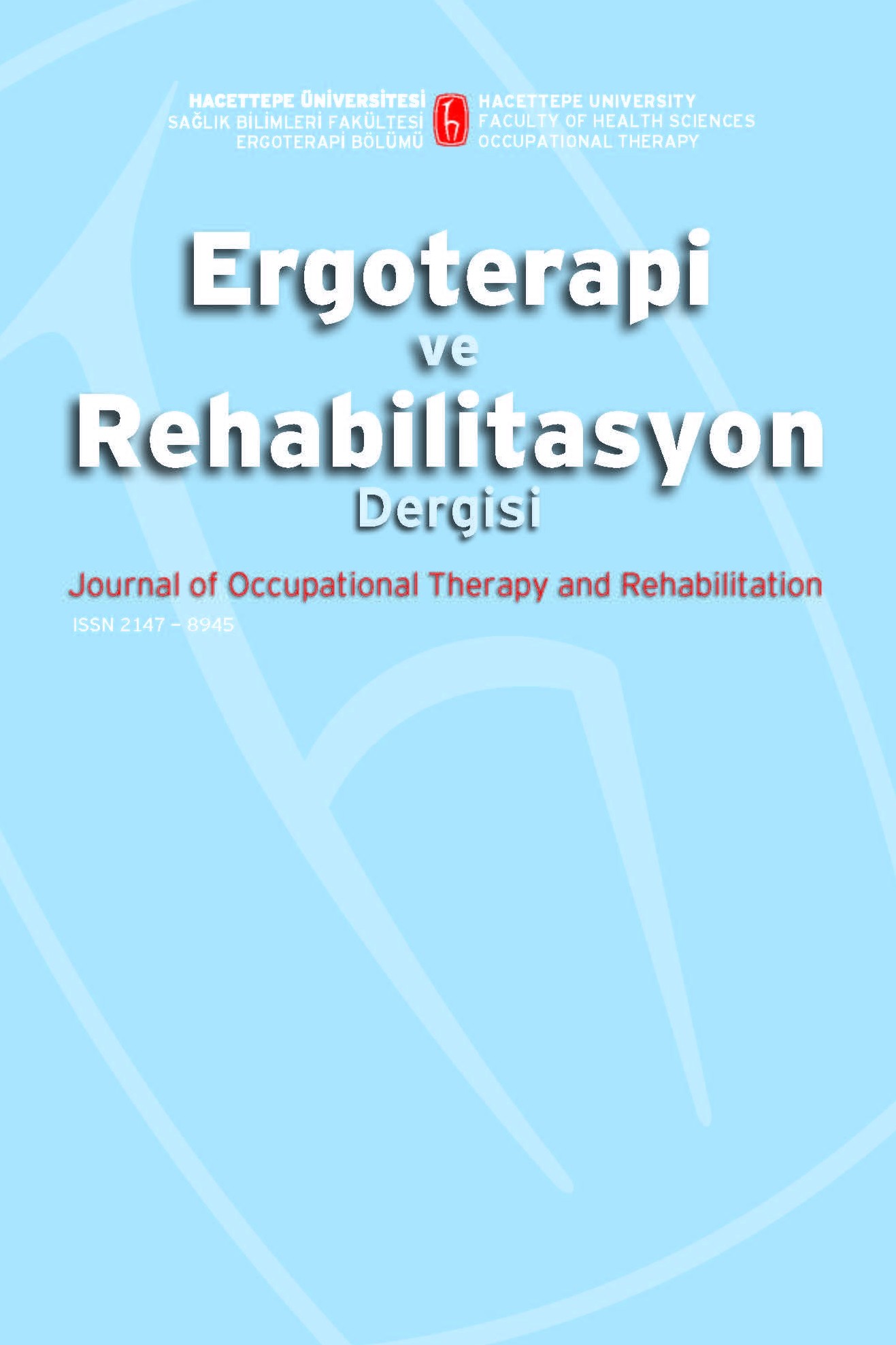Üstün Yetenekli Çocuklarda Duyu Temelli Ergoterapi Grup Müdahalesinin Duyu Modülasyonu, Postural Praksis ve Bilateral Motor Koordinasyon Becerileri Üzerindeki Etkisinin İncelenmesi: Pilot Çalışma
Amaç: Çalışmamızın amacı; üstün yetenekli çocuklarda duyu temelli ergoterapi müdahalesinin duyu modülasyonu, postural praksis ve bilateral motor koordinasyon becerileri üzerindeki etkisinin incelenmesidir. Gereç ve yöntem: Çalışmamıza Stanford Binet Zeka Testine göre görsel veya işitsel beceri performans alanlarından en az birinde yaşıtlarından daha üstün beceriye sahip olan 4-6 yaş arası 20 çocuk dahil edildi. Çocukların demografik bilgileri kaydedildi. Duyu modülasyonu Duyu Profili ile değerlendirilirken, postural praksis ve bilateral motor koordinasyon becerileri Duyusal Bütünleme ve Praksis Testi (SIPT)'nin postür taklidi ve bilateral motor koordinasyon alt testleri ile değerlendirildi. Değerlendirme sonuçlarına göre planlanan duyusal öğrenme grup programı 8 hafta boyunca haftada 1 kez-1 saat uygulandı. Testler 8 hafta sonra tekrarlandı ve sonuçlar istatiksel olarak karşılaştırıldı. Sonuçlar: Yaş ortalaması 5,10±0,29 yıl olan çocukların duyu modülasyonu, postural praksis, bilateral motor koordinasyon-kollar, bilateral motor koordinasyon-ayaklar alanlarında istatistiksel olarak anlamlı gelişim gözlendiği tespit edildi (p±0,05). Tartışma: Üstün yetenekli çocukların eğitim programlarına çocukların nörolojik eşik değerleri, regüle olma durumları, geribildirim ve ileri beslemeli mekanizmaları, duyusal uyarana adaptif cevap oluşturma mekanizmaları dikkate alınarak hazırlanan duyusal öğrenme grup programı duyu modülasyonu, praksis ve bilateral motor koordinasyon becerilerinin gelişimini olumlu yönde etkileyebilir. Konu ile ilgili ileri çalışmaların yapılması önerilmektedir.
Investigation of the Effects of Sensory-Based Occupational Therapy Group Intervention on Sen- sory Modulation, Postural Praxis and Bilateral Motor Coordination of Gifted Children: Pilot Study
Purpose: The aim of the study was to investigate of the effects of sensory-based occupational therapy intervention on sensory modulation, postural praxis and bilateral motor coordination of gifted children. Materials and Method: 20 kindergarten students between 4-6 years who have better skills than their peers in at least one area of visual or auditory skills performance according to Stanford Binet Test were included. The demographic profile of the children were saved. Sensory modulation was assessed by Sensory Profile while praxis and bilateral motor coordination skills were assessed by Sensory Integration and Praxis Test's postural praxis and bilateral motor coordination subtests. Sensory-based occupational therapy intervention was performed once a week for one hour for 8 weeks. Children were retested after 8 weeks and the results were compared statistically. Results: Average age of children were 8.8±2.31 years. Statistically significant development were found in mean scores for sensory modulation, postural praxis and bilateral motor coordination integration-arms, bilateral motor coordination-feet subtests (p±0.05). conclusion: Sensory-based occupational therapy group intervention programmes which designed according to children's neurological thresholds, regulatory statuss, feed-back and feed-forward mechanisms and highest adaptive response to sensory stimuli can effect the sensory modulation, postural praxis and bilateral motor coordination skills of the gifted children positively. Further comprehensive studies can be planned.
___
- Ayres, A. J. (1969). Deficits in sensory integration in educationally handicapped children. J Learn Disabil, 2(3), 160-168.
- Ayres, A. J. (1972). Sensory integration and learning disorders. Western Psychological Services.
- Bodison, S., & Mailloux, Z. (2006). The sensory integration and praxis tests illuminating struggles and strengths in participation at school. AOTA OT Pactice magazine, 11(17), 1-7.
- Bumin, G., Huri M., Salar S., & Kayihan. H., (2015). Occupational therapy in Autism. Autism Spectrum Disorder - Recent Advances. Fitzgerald M. (Ed.), InTech, DOI: 10.5772/59168. Available from: http:// www.intechopen.com/books/autism-spectrumdisorder-recent-advances/occupational-therapy-inautism.
- Case-Smith, J., & Bryan, T. (1999). The effects of occupational therapy with sensory integration emphasis on preschool-age children with autism. Am J Occup Ther, 53(5), 489-497.
- Case-Smith, J., & Miller, H. (1999). Occupational therapy with children with pervasive developmental disorders. Am J Occup Ther, 53(5), 506-513.
- Erişti, S. D. (2012). Üstün yetenekli öğrencilerin görsel anlatımlarında geleceğin dünyasına ve teknolojisine ilişkin algıları. Türk Üstün Zekâ ve Eğitim Dergisi, 2( 2), 102-117.
- Ermer J., & Dunn W. (1998). The Sensory profile: A discriminant analysis of children with and without disabilities. Am J Occup Ther, 52(4), 283-290.
- Gere, D. R., Capps, S. C., Mitchell, D. W., & Grubbs, E. (2009). Sensory sensitivities of gifted children. Am J Occup Ther, 64, 288-295.
- Iott, M. D. (2013). Occupational therapy sensory learning in developmental education program (OT SLIDE) :A program development plan. Doctora thesis, The University of Toledo, USA.
- Kayihan, H., Akel, B. S., Salar, S., Huri, M., Karahan, S., Turker, D.ve ark. (2015). Development of a Turkish version of the sensory profile: translation, crosscultural adaptation, and psychometric validation. Percept Mot Skills, 120(3), 971-986.
- May-Benson, T. A., & Schaaf, R. (2015). Ayres Sensory Integration® Intervention. In International Handbook of Occupational Therapy Interventions (pp. 633-646). Springer International Publishing.
- May-Benson, T. A., & Koomar, J. A. (2010). Systematic review of the research evidence examining the effectiveness of interventions using a sensory integrative approach for children. Am J Occup Ther, 64, 403- 414.
- Miller, L. J., Coll, J. R., & Schoen, S. A. (2007). A randomized controlled pilot study of the effectiveness of occupational therapy for children with sensory modulation disorder. Am J Occup Ther, 61(2), 228-238.
- Silverman, L. K. (2003). Gifted children with learning disabilities. Handbook of Gifted Education, 3, 533-543.
- Smith, T., Mruzek, D. W., & Mozingo, D. (2005). Sensory integration therapy. In J. W. Jacobson, R. M. Foxx, and J. A. Mulick (Eds.). Controversial therapies for developmental disabilities: Fad, fashion, and science in professional practice. Mahwah, New Jersey: Lawrence Erlbaum Associates.
- Vaivre-Douret, L. (2011). Developmental and cognitive characteristics of "high-level potentialities"(highly gifted) children. Int J Pediatr, 2011, 420297.
- Van Viersen, S., Kroesbergen, E. H., Slot, E. M., & de Bree, E. H. (2016). High reading skills mask dyslexia in gifted children. J Learn Disabil, 49(2), 189-199.
- ISSN: 2147-8945
- Yayın Aralığı: Yılda 3 Sayı
- Başlangıç: 2013
- Yayıncı: Hacettepe Üniversitesi Sağlık Bilimleri Fakültesi
Sayıdaki Diğer Makaleler
Eylem TÜTÜN YÜMİN, Meral SERTEL, Tülay TARSUSLU ŞİMŞEK
Isı Hassasiyeti Olan Multipl Skleroz Hastalarında Egzersiz Önerileri: Anlatımsal Bir Derleme
Ayla FİL, Yeliz SALCI, Kadriye ARMUTLU
Hatice ABAOĞLU, Esra AKI, Akfer KARAOĞLAN, Gamze EKİCİ, Huriye Gökçe ŞAHİN
Esra AKI, Banu ARSLANTEKİN ALTUNAY
Wistar Sıçanlarda Erken Dönem Deneyimlerinin Duyusal Motor Yanıtlar Üzerine Etkileri
